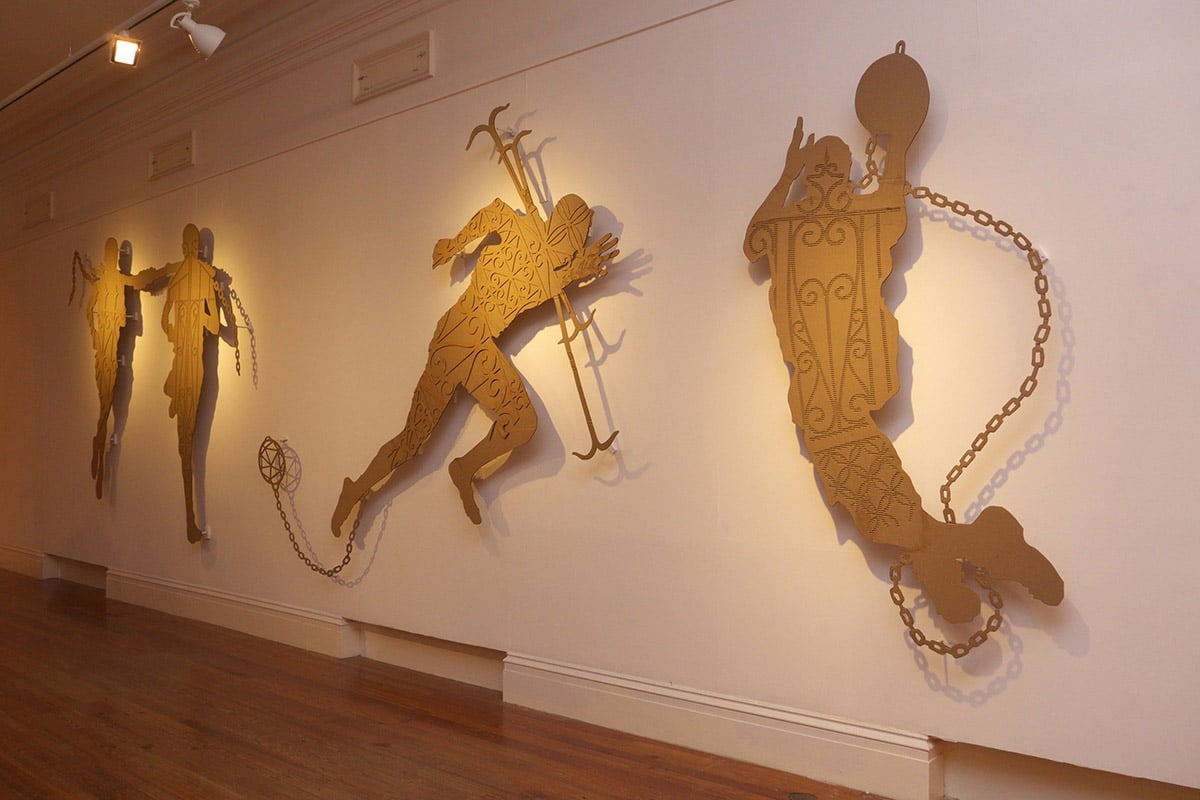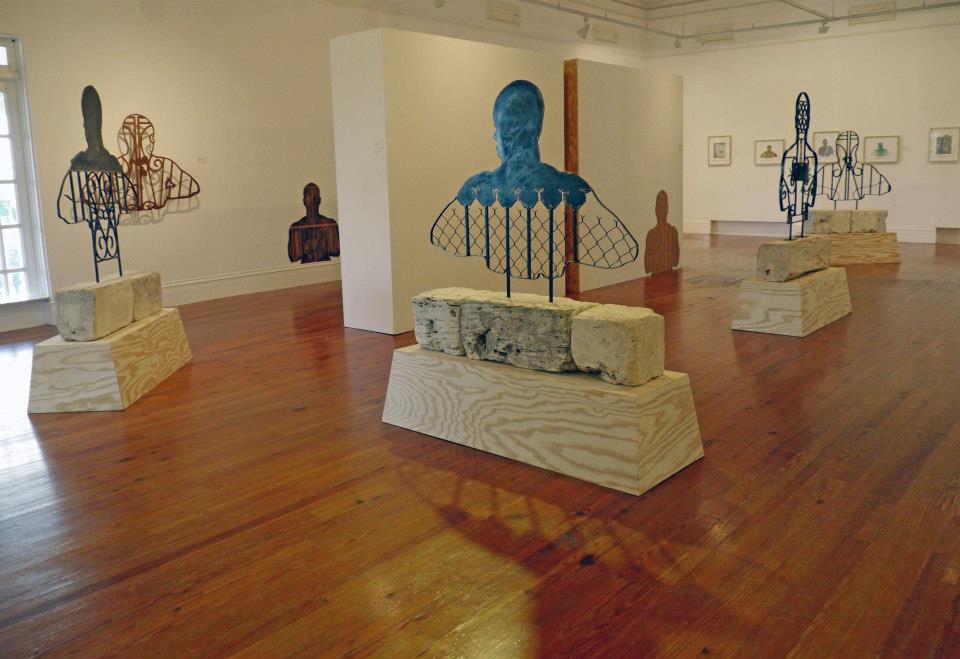
By Natalie Willis
Continuing with our series of artist interviews in the lead up to the opening of “We Suffer To Remain” on March 22nd, the product of a collaboration between the NAGB and the British Council, we stop to chat with John Beadle. Beadle is considered one of our master artists and works in a range of media. From painting to installations, his practice looks to some of the difficult aspects of the Bahamian condition and aesthetically shows his background in Junkanoo outside of his artist training.
John Beadle’s “Higher Goals” (2014) shown as part of the 7th National Exhibition. His work for “We Suffer To Remain” further investigates and expands these cardboard figures of Bahamian and Caribbean society.
NW: Since the jumping off point of this exhibition was “The Slave’s Lament” by Graham Fagen, tell me about your first thoughts or reactions on Fagen’s work.
JB: I didn’t like it. I wasn’t too thrilled about it and I thought it was patronizing to some extent.
NW: How so?
JB: It’s the gaze really. That might be me projecting on the work, but it’s a white man from Scotland talking about the ‘Slave’s Lament’. I assume the slave discussed would be a Black slave from the reading. And the video and the juxtaposition of this reggae singer with these European people playing classical music, that was… strange for me.
NW: Problematic for you then?
JB: Big time. While it felt slick, to me it didn’t feel respectful. The first thing that came to me when I started reading that poem was that it didn’t feel like someone who was in the situation of being displaced or feeling a serious longing or yearning or desperation to get back home. It’s almost a romantic gesture, too romantic to me, as opposed to “I need to get out this place”.
And I didn’t see the need to look in this man’s mouth, that was another turn off. Why so intimate with his mouth? I understand Graham does some drawings of mouths, but still, why so intimate with it? It took me back to examining the Black body for strength and pedigree, like horses. All of those ideas bubbling up. While I thought it was slick and interesting technically as an art piece, I didn’t like it for the reading I took from it.
NW: Sometimes even when people have the best intentions I suppose it’s hard to get away from their context and the way that plays into the historical gaze of certain demographics onto others.
JB: Yes. And then another thing, I heard there was a history of it being problematic to audiences, and there was some agitation when it was shown in Jamaica. So taking it and shopping it around to these spaces in the Caribbean, even that felt like a colonial approach. But that might be my angst.
NW: It’s always going to be something difficult to navigate and people are going to get a different experience or idea or feeling from it. That’s why the conversations need to be had perhaps, no?
JB: I wanna say yeah, but that’s an easy argument. You could talk about anything. Anything is a conversation to be had. It’s too easy, it’s almost a cop-out I feel.
And then the onus is put on the audience to engage in the conversation, and maybe one that wasn’t necessary to be brought up in that particular way. It’s not on the person who is presenting this argument or this piece, this idea. It’s on the audience to find what’s worthy in this thing and have a conversation.

NW: So let’s shift the focus to the conversation within your own work. This piece is a continuation of sorts of the work “Higher Goals” you produced for the 7th National Exhibition (NE7) with the giant cut-out cardboard figures, but it also looks like part of the larger series of work with silhouettes, and with the gate-patterned symbols in your work from The John Beadle project a few years ago… What’s different for you in this iteration, and how have you considered the figures in relation to this exhibition in particular?
JB: I been thinking on that, because I expected the question to come. This time I have populated the space with a more even balance of male and female figures than my piece in the NE7. It did come out of the work I did in the John Beadle Project on how we protect and guard space, and ideas of personal space, but for me that project was more of a self-portrait than anything else.
This current work is looking outward more, stepping back and trying to populate the space with a variety of sexes. Even thinking about that, once I included the feminine figure I started thinking about whether that refers to ideas of ‘male or female’, or people who consider themselves fluid when it comes to sex and gender, gay and lesbian issues, all of that.
The problem I’m having with this work is that the same way I’m critiquing Graham’s work I’m critiquing my own. Do I have the information and sensitivity to talk about bisexual, homosexual, lesbianism, fluid sexuality? So I stepped back. While I think it can be brought up in discussing the work, I don’t think it’s a conversation I want to stretch. I don’t know if I have the fluency or sensitivity to some extent.
NW: But you do have a fluency in cardboard, so talk to me about that material choice.
JB: Cardboard is ubiquitous. It’s a packing material and you throw it away, it’s something you overlook. After its initial use it becomes garbage. The question when I first had when I started using it, outside of thinking about in regards to Junkanoo, is how do use it as a metaphor for something else? I then started looking at painting and works of art as being precious. But the justification in using cardboard was that this is the same material as canvas in a way.
NW: Yes both are made of fibers in their own right really.
JB: And yet they’re both looked at very differently. I can take a piece of wood, shred it and put it in a pile, and take cardboard and shred it and pile it. Do you look at those the same way? Your response to it is in relation to your experience with cardboard or paper or cloth. As far as material is concerned, in my asking you to look at it in a different way I’m saying ‘do you recognize that these two things can be the same and can be treated the same?’ The only way you treat them differently is because of a hierarchy put in place by someone else.
“We Suffer to Remain” opens on March 22nd at 7:00 p.m. at the NAGB and is free and open to the general public. There will be an artist talk on Friday, March 23rd starting at 6 p.m. with participating artists Anina Major, John Beadle, Graham Fagen and Sonia Farmer.
